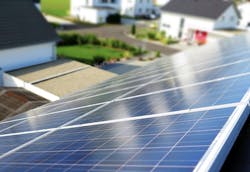Smart Device Partners and Energy Management for the Connected Home
Given that most homebuyers now consider features such as smart lighting, wireless audio, and utility sensors as must-haves rather than nice-to-haves, The New Home Company’s VP of marketing Megan Eltringham considers the Southern California production builder's wait-and-see approach a sound strategy.
But, knowing that the technology would improve and that customers would want it, Eltringham, along with New Home's chief marketing officer, Joan Webb, and other members of the home builder's team, made a pilgrimage in mid-2018 to the big three smart device makers: Amazon, Apple, and Google, to assess possible partnerships.
Finding the Right Fit
Each vendor had a compelling presentation, but for various reasons, the New Home team had reservations about inking a deal with any of them. Amazon was reportedly struggling to make its partnership with a major home builder work, Eltringham recalls, while Google wouldn’t offer an enticing volume discount on its devices, and Apple didn’t seem able (or willing) to provide its smart home kit with enough resources.
“We ultimately decided not to align with any of them, or anyone,” Webb says. “The brand decision is just too personal.”
RELATED
- Read the accompanying feature article on our sister website, Construct Utopia
- Why Builders Can’t Afford to Ignore the Smart Home Tech Trend
- 2019 Builder of the Year: The New Home Company
- 6 Steps for Building Smart, Connected Homes
Integrating Energy With the Connected Home
When microgrid energy technology provider Racepoint Energy joined its parent company, connected home integrator/vendor Savant, in a partnership with Blue Heron, a custom home builder and high-end single-family-home community developer, it added an energy management component to the Las Vegas builder’s connected home offering.
Simply, Racepoint’s solution enables automated energy load transfer from solar panels to home power storage units to optimize that storage, thus minimizing energy purchases from the grid during peak time-of-use periods (think: air conditioning on a summer afternoon in Las Vegas). The technology also makes going off-grid easier. “It could potentially disrupt how we use energy,” says Blue Heron’s owner and founder, Tyler Jones.
California Energy Codes and Solar
Energy load management has become more critical in California after the passage of Title 24, a sweeping series of energy codes that basically require solar power to achieve a net-zero energy balance in all new homes (a deadline that has been extended from 2020 to 2022 due to the impact of COVID-19 on the industry and economy).
Similarly, The New Home Company partners with Savant to specify and supply breaker-companion modules for its homes in California. The equipment provides energy use and utility grade reporting data to inform net zero-compliant home design, bringing New Home’s commitment to both connected/smart home technology and energy efficiency to a new level.
Indeed, energy management could turn into the killer app for smart home technology, at least in California. Golden State builders are looking intently at new options to boost efficiency, says Dan Ross, Racepoint’s VP of sales. “Lighting, climate, and energy are at the core of what they want to offer.”
RELATED
- How Can Builders Prepare for More Solar?
- Myths and Misconceptions About Going Solar
- Net Zero Energy: The Ultimate Z.E.N. Home's Solution for Solar


